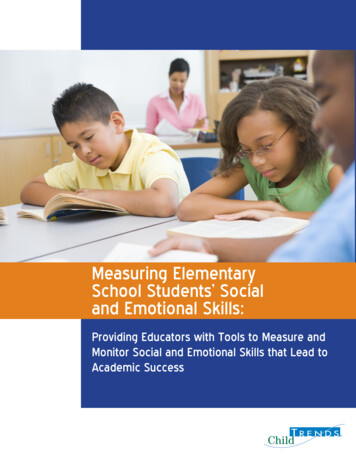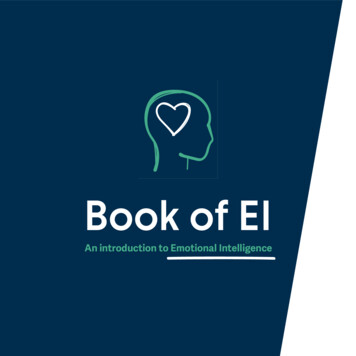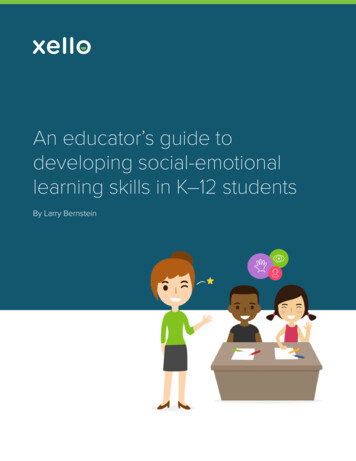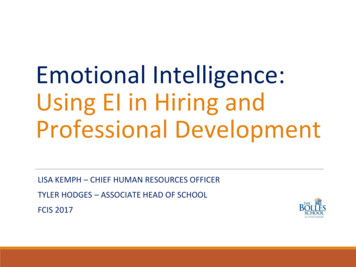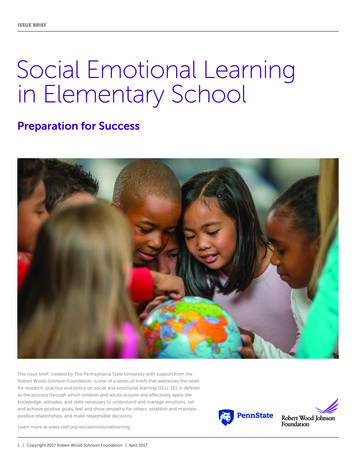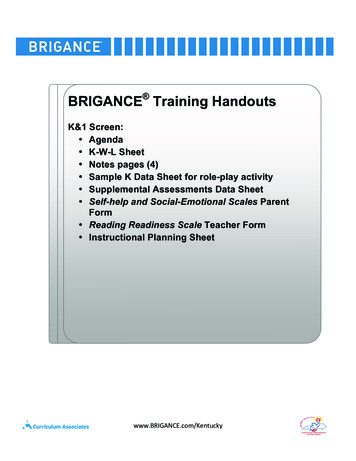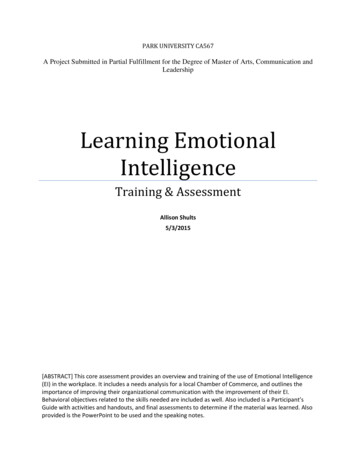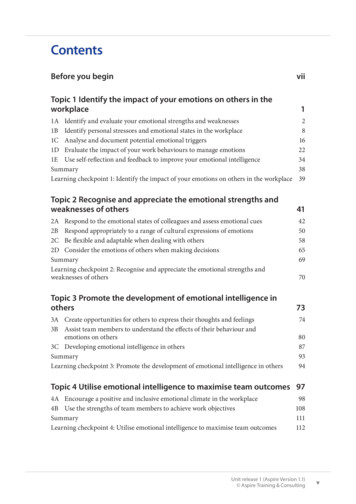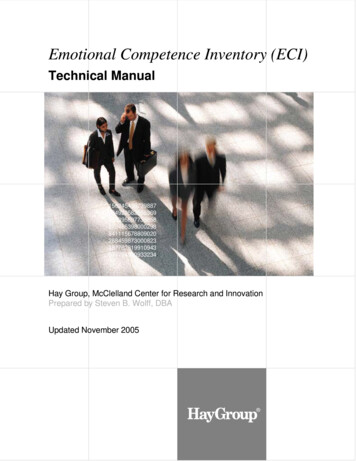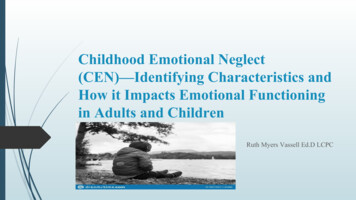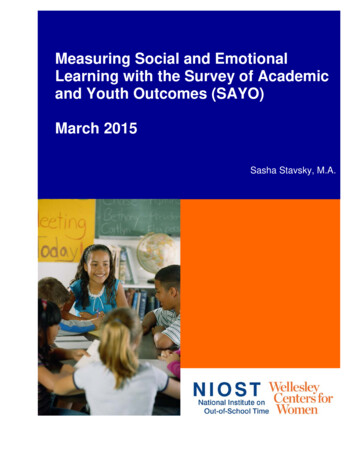
Transcription
Measuring Social and EmotionalLearning with the Survey of Academicand Youth Outcomes (SAYO)March 2015Sasha Stavsky, M.A.
Table of Contents1Introduction11 Using SAYO for ProgramImprovement and MeasuringImpact2What is Social and EmotionalLearning?13 Summary3Defining Social and EmotionalLearning Competencies14 Endnotes4The Survey of Academic andYouth Outcomes (SAYO): A Toolfor Measuring Social andEmotional LearningCompetencies15 Appendix A: Defining Social andEmotional Learning Competencies:Four SEL Frameworks5Aligning the SAYO Tools withFour SEL Frameworks18 Appendix B: The Development andTesting of the APAS ToolsAcknowledgementsThe author would like to thank the following individuals for their assistance in conceptualizing thisreport, as well as for providing critical feedback and support throughout the writing process:Wendy Surr, M.A.American Institutes for ResearchDale Blyth, Ph.D.College of Education and Human Development, University of MinnesotaEllen Gannett, M.Ed.Kathy Schleyer, M.S.Julie Dennehy, M.M.Judy Chin, M.S.National Institute on Out-of-School Time, Wellesley Centers for WomenSuggested Citation:Stavsky, S. (2015). Measuring social and emotional learning with the Survey of Academic and YouthOutcomes (SAYO). Wellesley, MA: National Institute on Out-of-School Time.Editing: Jenny Lisle, M.Ed.
IntroductionOver the past decade, growing evidence has pointed to the unique and positive role outof-school time (OST) programs can play in the lives of young people. Durlak andWeissburg’s 2007 examination of the impact of youth development programs onpersonal and social skills has suggested that participation in OST programs isassociated with youth’s feelings of self-confidence and self-esteem, positive feelings andattitudes towards school, positive social behaviors, and reduced problem behaviors suchas aggression and noncompliance. i With this increased recognition has come increasedresources for OST programs; with increased resources has come higher expectationsfor results. A recent report from Grantmakers for Education indicates that the four mostcommon outcomes grantmakers seek for youth through their grants to OST programsare (1) improved academic achievement, (2) increased student engagement, (3) positiveyouth development, and (4) 21st century skill building. iiOST programs, which typically draw from positive youth development theory, havehistorically focused their efforts on nurturing the development of a foundational set ofsocial and emotional skills, attitudes, and behaviors in youth that can contribute toyouth’s future academic and life successes. iii,iv Over the years, the terms used to refercollectively to these nonacademic skills, attitudes, and behaviors have gone by anumber of different names, each with their own definitions: “intermediary outcomes,”“noncognitive skills,” “soft skills,” “emotional intelligence,” “resiliency,” “21st centuryskills,” and, most recently, “grit.” While social and emotional competencies are a subsetof skills that define many of these terms, the phrase “social and emotional learning” (or“SEL”) has become the umbrella term for this entire set of skills, attitudes, and behaviors.Recently, a number of research consortia and other organizations have developedframeworks that seek to identify and define these SEL competencies. Some of thesegroups, however, have noted that the development of valid and reliable measurementtools to assess youth outcomes in SEL competency areas has not kept pace with thefield. v,vi This paper seeks to demonstrate how the Survey of Academic and YouthOutcomes (SAYO), a tool developed by the National Institute on Out-of-School Time(NIOST) and used in the OST field for over a decade, can measure many of the SELcompetencies of interest to the OST field.We begin with a general definition and brief history of SEL research and highlight fourrecent efforts to define a set of core SEL competencies. Next, we provide a briefdescription of the SAYO tools. We then describe the extent of alignment between SELcompetencies highlighted in the four frameworks with the youth outcome areasmeasured by the SAYO tools. Finally, we include profiles on how the tools are beingused in the field for program improvement and to measure impact.Measuring Social and Emotional Learning with the Survey of Academic and Youth Outcomes1
What Is Social and Emotional Learning?Social and emotional learning, or SEL, has become the recognized term to refer to thefoundational skills, attitudes, and behaviors that facilitate the development of keyintrapersonal and interpersonal skills that help promote school engagement and set thestage for later success. The field of social and emotional learning grew out of the work ofHoward Gardner, Peter Salovey, and John D. Mayer in the mid 1980s and 1990s. Thesetheorists argued that traditional measures of intelligence—those that narrowlyemphasize proficiency in mathematical and verbal skills—fail to recognize equallyimportant aptitudes in nonacademic domains. Gardner’s 1983 book, Frames of Mind:The Theory of Multiple Intelligences vii, identified eight domains in which people mayexhibit special abilities: logical-mathematical, linguistic, musical, spatial, bodilykinesthetic, interpersonal, intrapersonal, and naturalistic. Gardner proposed that acrossthese eight intelligence domains individuals possess a unique blend of abilities that worktogether to support skill development and problem solving. viiiIn 1990, Salovey and Mayer published a review of the research on emotion-related skillsin order to examine the place of social and emotional skills in intelligence. A key result ofSalovey and Mayer’s review was the identification of the constructs that make up theconcept of “emotional intelligence.” Salovey and Mayer defined emotional intelligence as,“the ability to monitor one’s own and others’ feelings and emotions, to discriminateamong them, and to use this information to guide one’s thinking and actions.” ix DanielGoleman’s 1995 book, Emotional Intelligence, popularized the work of Salovey andMayer. While recognizing the importance of intellect and expertise for achievement in lifeand the workplace, Goleman proposed that emotional intelligence—that is, one’s abilityto understand, empathize, and negotiate with other people—gives individuals additionaladvantages for achieving success. x More recent research, such as Durlak andWeissberg’s 2011 meta-analysis of school-based social and emotional learningprograms, xi has continued to lend evidence that SEL is associated with and key toacademic success.Measuring Social and Emotional Learning with the Survey of Academic and Youth Outcomes2
Defining Social and Emotional Learning CompetenciesIn recent years, a number of research consortia and other organizations have publishedvarying frameworks to define the specific SEL skills, attitudes, and behaviors believed tobe associated with long-term youth outcomes. Some of these frameworks are based onreviews of the research literature, while others are compilations of previously developedSEL frameworks. For the purposes of this report, we have chosen to focus on four of themost recently published and frequently cited frameworks: the Collaborative for Academic,Social, and Emotional Learning (CASEL) Social and Emotional Learning CoreCompetencies; the University of Chicago Consortium on Chicago School Research(CCSR) Noncognitive Factors; the Forum for Youth Investment Skill Areas; and theEvery Hour Counts Measurement Framework. The SEL competencies identified by eachof these four frameworks are listed in Table 1. (See Appendix A for descriptions offrameworks.)Table 1. Four Frameworks of Social and Emotional Learning CompetenciesCASEL SEL l awarenessRelationship skillsResponsible decisionmakingEvery Hour CountsMeasurementFrameworkEngagementForum for YouthInvestment SkillAreasCommunicationDevelopment ofpositive skills & beliefsRelationships &collaborationEducationCritical thinking &decision makingInitiative & selfdirectionCCSR NoncognitiveFactorsAcademic behaviorsAcademic mindsetsLearning strategiesAcademicperseveranceSocial skillsWhile there are variations in how organizations define SEL, commonalities emergeamong the competencies that are included in their frameworks. These commonalitiescan be summarized as: Intrinsic motivation (initiative, persistence, self-direction)Critical thinking skills (problem solving, metacognitive skills, reasoning andjudgment skills)Relational skills (communication, cooperation, empathy)Emotional self-regulation (impulse control, stress management, behavior)Self-concept (knowing one’s own strengths and limitations, belief in one’s abilityto succeed, belief that competence grows with effort)Measuring Social and Emotional Learning with the Survey of Academic and Youth Outcomes3
The Survey of Academic and Youth Outcomes (SAYO):A Tool for Measuring Social and Emotional LearningCompetenciesTo satisfy funders’ expectations for results, OST programs mustbe able to demonstrate in a measurable way that the work theyare doing is having a positive influence on these important SELskills, attitudes, and behaviors. While there are a number ofcompendia that list and describe existing, valid, and reliablemeasures of SEL competencies in children and youth, xii,xiii,xiv,xvmany of the compendia that have been published have limitedapplication for the OST field. For example, some review toolsthat are typically used in clinical or diagnostic settings whileothers restrict their search to include only those measuresdescribed in articles published in peer-reviewed academicjournals, which may have limited availability beyond theresearch studies for which they were developed.The SAYO tools are reliable and validated staff, teacher, andyouth surveys that measure selected SEL competencies. TheSAYO tools represent components of an integrated assessmentsystem, the APAS (A Program Assessment System). APAS wasdeveloped specifically for use in the OST field by NIOST, inpartnership with the Massachusetts Department of Elementaryand Secondary Education (MA ESE), over a ten-year periodbeginning in 2001. APAS is comprised of three integratedmeasurement tools that are research based and scientificallytested: the Survey of Academic and Youth Outcomes Staff andTeacher Surveys (SAYO-S & SAYO-T), the Survey of Academicand Youth Outcomes Youth Survey (SAYO-Y), and theAssessment of Program Practices Tool (APT). Appendix Bdescribes the development and testing of these tools in greaterdetail.SAYO-S & SAYO-T measure keyintermediary youth outcomes thatresearch suggests are linked tolong-term positive developmentand academic and life success:BehaviorInitiativeEngagement in LearningProblem-Solving SkillsCommunication SkillsRelations with AdultsRelations with PeersHomeworkAcademic Performance(SAYO-T only)SAYO-Y provides a youthperspective on program quality aswell as youth’s attitudes andbeliefs in key areas linked to theirlong-term academic success. TheSAYO scales are grouped intothree main sections:Program ExperienceSense of CompetenceFuture Planning andExpectationsMeasuring Social and Emotional Learning with the Survey of Academic and Youth Outcomes4
Aligning the SAYO Tools with Four SEL FrameworksComparative analyses were made to explore the extent to which the SAYO tools alignwith the four SEL frameworks listed in Table 1. In order to make the tables easier toread, the sub-elements of the main constructs have not been included (see Appendix Ato review these sub-elements). Two of these analyses have already been conducted byThe Forum for Youth Investment and Every Hour Counts (see Tables 2 and 3). xvi,xviiTable 2. Forum for Youth Investment Skill Areas Aligned with SAYO OutcomesFuture Planning – My ActionsFuture ExpectationsFuture Planning – Talk to an Adult Sense of Competence – Socially Sense of Competence – LearnerRelations with PeersSAYO-YRelations with AdultsCommunication SkillsProblem-Solving SkillsEngagementInitiativeBehaviorSEL COMPETENCYCommunicationRelationships & CollaborationCritical Thinking & Decision MakingInitiative & Self-DirectionHomeworkSAYO-S/SAYO-T Note. The first column lists the key constructs of the Forum for Youth Investment Skill Areasframework. The remaining columns indicate the SAYO-S/SAYO-T or SAYO-Y scales that theForum for Youth Investment has determined measure the same or similar SEL competency area.Measuring Social and Emotional Learning with the Survey of Academic and Youth Outcomes5
Table 3. Every Hour Counts Measurement Framework Aligned with SAYO Outcomes* **Note. The first column lists the key constructs of the Every Hour Counts MeasurementFramework. Some of the sub-elements within Engagement, such as “high, sustained programattendance,” and “high year-to-year retention,” rely on participation data, which are not collectedby the SAYO. These sub-elements were not included in this alignment. Similarly, the constructEducation is not included in this alignment because it relies on a review of school records.The remaining columns indicate the SAYO-S/SAYO-T or SAYO-Y scales that Every Hour Countshas determined measure the same or similar SEL competency area.* Every Hour Counts did not include the SAYO-S/SAYO-T Engagement scales in their alignment.NIOST believes that they are a good fit for the High Levels of Program EngagementExperienced/Demonstrated by Youth construct. In addition, the SAYO-Y Enjoyment andEngagement scale provides youth perspective on this construct.** Every Hour Counts did not review the SAYO-Y. NIOST believes that the SAYO-Y Sense ofCompetence – Learner scale is a good fit for this construct.Measuring Social and Emotional Learning with the Survey of Academic and Youth Outcomes6Future Planning – My ActionsFuture ExpectationsFuture Planning – Talk to an AdultSense of Competence – SociallySense of Competence – LearnerRelations with PeersSAYO-YRelations with AdultsCommunication SkillsProblem-Solving SkillsEngagementInitiativeBehaviorSEL COMPETENCYEngagementHigh Levels of Program EngagementDevelopment of Positive Skills & BeliefsCritical municationGrowth MindsetHomeworkSAYO-S/SAYO-T
For the CASEL and CCSR frameworks, we conducted a comparative analysis at twolevels: by construct and by item. The first level of analysis was to explore the alignmentof the SAYO and the CASEL and CCSR frameworks by SEL competency area. Thislevel of analysis proved challenging since competency areas with similar names werefound to have differing definitions. For example, CASEL defines Responsible DecisionMaking as, “the ability to make constructive and respectful choices about personalbehavior and social interactions based on consideration of ethical standards, safetyconcerns, social norms, the realistic evaluation of consequences of various actions, andthe well-being of self and others.” A similar SAYO construct, Problem-Solving Skills, isdefined as, “youth are able to think through and solve problems.” The CASEL constructemphasizes decision making as it relates to personal behavior and social interactions,whereas the SAYO construct is more focused on youth’s ability to identify a problem andcome up with multiple solutions as well as persistence on a task.An item-by-item comparison of the SAYO scales with the constructs defined in theCASEL and CCSR frameworks proved more fruitful. The results of this detailedcrosswalk showed that the extent of alignment between the SAYO and the constructsincluded in these frameworks varied. It is important to note that for several of the CASELand CCSR constructs more than one SAYO scale was needed to fully capture the SELcompetency area as defined in the frameworks. In some cases the alignment wasstrong: the definition of the constructs and/or sub-constructs matched and 75% or moreof the SAYO items for a construct aligned closely with these definitions. In some cases,we found moderate alignment for some of the SEL competency areas: there was onlypartial alignment in the definitions of constructs and 50%–75% of the SAYO items in ascale aligned with constructs. Finally, for some CASEL and CCSR constructs there waslittle or no alignment with SAYO scales.Please note that these analyses did not include any statistical tests of association (e.g.,correlations) between constructs measured in the SAYO tools and the SEL frameworks.The results of these crosswalks are shown in Tables 4 and 5.Measuring Social and Emotional Learning with the Survey of Academic and Youth Outcomes7
Table 4. CASEL SEL Core Competencies Framework Aligned with SAYO Outcomes Note. The first column lists the key constructs of the CASEL SEL Core Competencies framework.The remaining columns indicate the SAYO-S/SAYO-T or SAYO-Y scales that measure the sameor similar constructs.SAYO constructs that demonstrate strong alignment (i.e., 75% or more of the items alignedclosely with the SEL framework construct) are indicated with a checkmark ( ). SAYO constructsthat demonstrate moderate alignment (i.e., 50%–75% of the items aligned closely with the SELframework construct) are indicated with a dot ( ).Measuring Social and Emotional Learning with the Survey of Academic and Youth Outcomes8Future Planning – CollegeFuture Planning – My ActionsSense of Competence – Socially Future ExpectationsSense of Competence – LearnerRelations with Peers Future Planning – Talk to an Adult SAYO-YRelations with AdultsCommunication Skills Problem-Solving SkillsInitiative EngagementBehaviorSEL COMPETENCYSelf-AwarenessSelf-ManagementSocial AwarenessRelationship SkillsResponsible Decision MakingHomeworkSAYO-S/SAYO-T
Table 5. CCSR Noncognitive Factors Aligned with SAYO Outcomes Future Planning – CollegeFuture Planning – My ActionsFuture ExpectationsFuture Planning – Talk to an AdultSense of Competence – SociallySense of Competence – LearnerRelations with PeersSAYO-YRelations with AdultsCommunication SkillsProblem-Solving SkillsEngagementInitiativeBehaviorSEL COMPETENCYAcademic BehaviorsAcademic MindsetsLearning StrategiesAcademic PerseveranceSocial SkillsHomeworkSAYO-S/SAYO-T Note. The first column lists the key constructs of the CCSR Noncognitive Factors framework. Theremaining columns indicate the SAYO-S/SAYO-T or SAYO-Y scales that measure the same orsimilar constructs.SAYO constructs that demonstrate strong alignment (i.e., 75% or more of the items alignedclosely with the SEL framework construct) are indicated with a checkmark ( ). SAYO constructsthat demonstrate moderate alignment (i.e., 50%–75% of the items aligned closely with the SELframework construct) are indicated with a dot ( ).Measuring Social and Emotional Learning with the Survey of Academic and Youth Outcomes9
The results of these crosswalks indicate that SAYO measures all of the SEL competencyareas included in the four frameworks. The Forum for Youth Investment’s analysisdemonstrates that SAYO includes measures for all four of its skill areas. With theinclusion of the SAYO-S/SAYO-T Engagement measurement area, the SAYO alignswith all of the Every Hour Counts outcomes. NIOST found a strong alignment with SAYOfor all five of CASEL’s SEL competency areas. Finally, SAYO showed strong alignmentwith three of the CCSR noncognitive factors (Academic Behaviors and AcademicMindsets) and moderate alignment with the remaining two (Learning Strategies andAcademic Perseverance.) These results are summarized in Table 6.Table 6. Summary of SAYO/SEL Framework CrosswalksSAYO-S/SAYO-TForum for Youth Investment Skill AreasCommunicationRelationships & CollaborationCritical Thinking & Decision MakingInitiative & Self-DirectionEvery Hour Counts Measurement FrameworkEngagementDevelopment of Positive Skills & BeliefsCASEL SEL Core CompetenciesSelf-AwarenessSelf-ManagementSocial AwarenessRelationship SkillsResponsible Decision MakingCCSR Noncognitive FactorsAcademic BehaviorsAcademic MindsetsLearning StrategiesAcademic PerseveranceSocial Skills SAYO-Y Measuring Social and Emotional Learning with the Survey of Academic and Youth Outcomes10
Using SAYO for Program Improvement and Measuring ImpactAs the comparative analyses show, the SAYO tools offer measures of the keyfoundational SEL skills for the promotion of longer-term youth outcomes. The SAYO canhelp programs build and demonstrate their contributions to academic and other longterm goals for youth by helping programs stay focused on outcomes that are mostappropriate and realistic to expect from participation in OST programs.The SAYO is currently being used by afterschool, extended day, and summer programsacross the country and in Canada. In addition, the SAYO surveys represent a corecomponent of the Massachusetts 21st Century Community Learning Centersaccountability system. Two programs, CommonBond Communities and Providence AfterSchool Alliance (see box), highlight different ways in which the SAYO tools are beingused: at the program-level for program improvement and at the system-level todemonstrate impact.CommonBond CommunitiesCommonBond Communities provides affordable housing and other services in Saint Paul, MN,including programming for children and youth. CommonBond is part of the Sprockets network, asystem of afterschool and summer programs working in collaboration with community organizations,the City of Saint Paul, and the Saint Paul Public Schools to improve the quality, availability, andeffectiveness of OST experiences for youth. Since 2011, Sprockets has been using the SAYO-S andSAYO-Y surveys in some of its networked programs to provide insights on how SEL skills impactyouth development.Participating programs collect fall and spring SAYO data, which are used—in conjunction withparticipation and program quality data—as part of an improvement planning process. Through groupcoaching activities such as workshops and webinars, Sprockets helps programs use their data toselect improvement areas, provides guidance on the development and implementation of improvementplans, and suggests possible topics for professional development and training.When CommonBond receives their SAYO data reports, they look at the results site-by-site as well asorganization-wide to come up with a program improvement plan for the year. CommonBond comparestheir SAYO results with quality observations of their programming to determine where theirprogramming is strong and where they could improve. In the past year, CommonBond focused on theresults of their SAYO-Y data to help them understand how teens are experiencing their teenleadership programs. While the program was receiving high scores in leadership and responsibility onthe program quality survey, their SAYO-Y ratings in this area indicated otherwise. CommonBondrecognized that this was an issue of perception rather than practice, and they have made efforts to bemore intentional about how they communicate the goals and objectives of activities to youth. As aresult, their leadership and responsibility scores have improved.Measuring Social and Emotional Learning with the Survey of Academic and Youth Outcomes11
Providence After School AllianceThe Providence After School Alliance (PASA) operates two citywide afterschool systems: theAfterZone for middle school youth and the Hub for high school youth. These systems includecommunity-based and expanded learning programs that reach over 2,000 youth across the city ofProvidence. PASA partners with the Providence Public School District to provide an integrated,year-round, in- and out-of-school learning experience.Over the past few years, PASA has administered SAYO-T and SAYO-Y surveys across itssystems to measure the potential impacts of program participation on a set of targeted youthoutcomes as well as to provide feedback to inform ongoing program improvements. PASA collectsdata on teachers’ perceptions of youth’s academic performance in ELA and Mathematics,initiative, engagement in learning, problem-solving skills, communication skills, and peer relations.In addition, youth provide feedback on their program experiences and how their participation in theprogram has contributed to their sense of competence socially and as learners.Using the SAYO data, as well as national OST research, PASA has developed a “graduateprofile,” which focuses on ensuring that AfterZone and Hub participants leave their programs withthe 21st century skills they need to succeed in college and career. The graduate profile has beenintegral to recent strategic planning across the systems, helping to inform training and professionaldevelopment, strengthen assessment and evaluation, and identify funding needs to supportprograms.In addition, PASA is using the youth outcomes data it collects from the SAYO to help setbenchmarks for the development of a digital badging system. Digital badges—much like meritbadges awarded by the Scouts—provide recognition for learning and achievement in specific skillareas. PASA’s digital badging system will allow participating youth to earn badges incompetencies such as communication skills and critical thinking. These badges can help youthdemonstrate the relevance of the learning and skills they have achieved in their afterschoolexperiences to potential employers and higher education institutions.Measuring Social and Emotional Learning with the Survey of Academic and Youth Outcomes12
SummaryAs the benefits of OST participation have become more widely known, xviii manypolicymakers, funders, schools, and communities have begun to expect moremeasureable results from OST programs. In particular, there is growing interest by avariety of stakeholders for OST programs to demonstrate how they impact social andemotional learning. The Forum for Youth Investment’s guide From Soft Skills to HardData xix and the Every Hour Counts Measurement Framework xx identifies a number oftools that OST programs could use to assess the key SEL skills, attitudes, and behaviorsthat lead to positive long-term results for youth. Not all of the tools included, however,have been used or tested in OST settings. The SAYO tools, by contrast, have been usedin the OST field for over a decade and offer measures of all of the SEL competenciesthat have been identified to be key foundational SEL skills for the promotion of longerterm youth outcomes. As the comparative analyses suggest, many of the SAYO scaleswould be suitable assessment tools for use by programs interested in measuring youth’sSEL skills included in multiple SEL frameworks.Measuring Social and Emotional Learning with the Survey of Academic and Youth Outcomes13
iDurlak, J. A., & Weissberg, R. P. (2007). The impact of after-school programs that promotepersonal and social skills. Chicago, IL: Collaborative for Academic, Social, and EmotionalLearning.iiGrantmakers for Education Out-of-School Time Funder Network. (2014). Grantmakers andthought leaders on out-of-school time: Survey and interview report. Portland, OR: Grantmakersfor Education.iiiHall, G., Yohalem, N., Tolman, J., & Wilson, A. (2002). Promoting positive youth developmentas a support to academic achievement. National Institute on Out-of-School Time with Forum forYouth Investment. Boston, MA: Boston’s After-School for All Partnership.ivUniversity of Minnesota Extension Service. (1999). Keys to quality youth development. St. Paul,MN: Author.vHumphrey, N., Kalambouka, A., Wigelsworth, M., Lendrum, A., Deighton, J., & Wolpert, M.(2011). Measures of social and emotional skills for children and young people: A systematicreview. Educational and Psychological Measurement, 71(4), 617–637.viWilson-Ahlstrom, A., Yohalem, N., DuBois, D., Ji, P., & Hillaker, B. (2014). From soft skills tohard data: Measuring youth program outcomes. Washington, DC: The Forum for YouthInvestment.viiGardner, H. (1983). Frames of mind: The theory of multiple intelligences. New York, NY: BasicBooks.viiiGardner, H. (1999). Intelligence reframed: Multiple intelligences for the 21st century. New York,NY: Basic Books.ixSalovey, P., & Mayer, J. D. (1990). Emotional intelligence. Imagination, Cognition, andPersonality, 9, 185–211.xGoleman, D. (1995). Emotional intelligence. New York, NY: Bantam Books.xiDurlak, J. A., Weissberg, R. P., Dymnicki, A. B., Taylor, R. D., & Schellinger, K. B. (2011). Theimpact of enhancing students’ social and emotional learning: A meta-analysis of school-baseduniversal interventions. Child Development, 82(1), 405–432.xiiDenham, S. A. (2005). Assessing social-emotional development in children from a longitudinalperspective for the National Children’s Study: Social-emotional compendium of measures. Fairfax,VA: George Mason University.xiiiDenham, S. A., Ji, P., & Hamre, B. (2010). Compendium of preschool through elementaryschool social-emotional learning and associated assessment measures. Chicago, IL: CASEL.xivHaggerty, K., Elgin, J., & Woolley, A. (2011). Social-emotional learning assessment measuresfor middle school youth. Seattle, WA: Raikes Foundation.xvHumphrey, et al. (2011).xviWilson-Ahlstrom, A., et al. (2014).xviiEvery Hour Counts. (2014). Every Hour Counts measurement framework: How to measuresuccess in expanded learning systems. New York, NY: Author.xviiiDurlak & Weissberg. (2007).xixWilson-Ahlstrom, A., et al. (2014).xxEvery Hour Counts. (2014).Measuring Social and Emotional Learning with the Survey of Academic and Youth Outcomes14
Appendix A: Defining Social and Emotional Learning Competencies—FourSEL FrameworksCollaborative for Academic, Social, and Emotional Learning (CASEL) FrameworkCollaborative for Academic, Social, and Emotional Learning. (2013). What is Social andEmotional Learning? Retrieved from CASEL defines social and emotional learning as, “the processes through which childrenand adults acquire and effectively apply the knowledge, attitudes, and skills necessary tounderstand
The Survey of Academic and Youth Outcomes (SAYO): A Tool for Measuring Social and Emotional Learning Competencies . To satisfy funders' expectations for results, OST programs must be able to demonstrate in a measurable way that the work they are doing is having a positive influence on these important SEL
